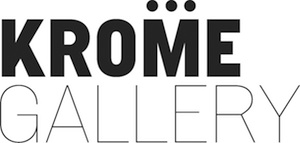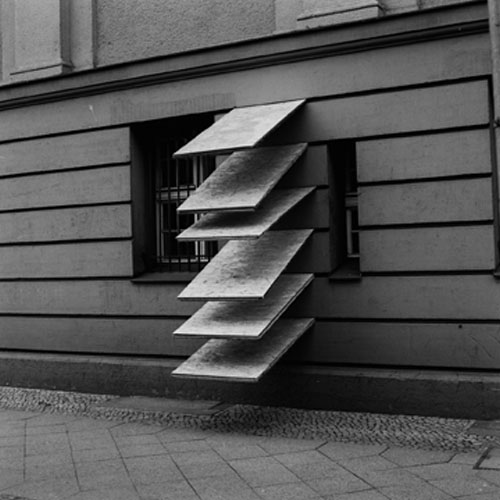PPP
Rocco Berger
Grischa Lichtenberger
Mickaël Marchand
Lorenzo Scotto di Luzio
•
20.03. - 05.04.2012
Opening: 17.03.2012, 6-9 pm
click the picture to launch gallery
•
KROME Gallery has invited a group of artists to participate in the show “PPP“, which aims to reflect on the contemporary sculpture as an eventful engagement with the spatial production, performativity and socially charged materiality.
By shifting the focus from sculpture approached as an object or outcome, to sculpture regarded as an expanded practice in motion, irreducible to a single instance providing a formal unity, the exhibition presents each of the artworks as a mutable spatiality.
Shaped by the interaction between the individual intentions of the artists and the general means of production and reproduction of social space, the contributions provide a contemplative mapping of particular social landscapes or private habitats, expose the design of their access policies, or question their compatibility with the white cube environment and the art market in general.
The process of selectively registering the chaotic complexity of space and transforming the chosen sample into a formally masterful “spatiality of situation” displays loose links with the aesthetic principals of minimalism and land art of the 1960/70s. On the other hand, practices like creative appropriation of public space, or deliberate cultivation of intimate art-dilettantism as a private shelter from market-shaped culture, depict the issues relevant to the present-day social plastic.
We are aware that the show may include overlapping territorial claims. There has always been a tension between seeing locality either as a site specific ready-made or as a plain building site.
•
Mickaël Marchand has brought a tiny fragment from a line one can follow in the streets of Neukölln district for more than 3 kilometres to the gallery space. Carved thoroughly in the cobble stone pavement it bespeaks a loud, dusty and labour-intensive effort, but provides no clues about any particular reason behind it.
The incision is hardly to be noticed in the quotidian flow and becomes almost invisible when rain has soaked the chalky-white cut and rendered it grey like the rest of the paving. Children overtaken by the irrational fear to step on the cracks between the pavement tiles definitely detect it. Situationists, too. And presumably Michael Heizer since it would remind him the legendary land art piece in front of Kunsthalle Bern in 1969.
The sample displayed in the gallery provides a close-up inspection of the engraving. A saw has furrowed the urban surface and dredged up the primeval materiality behind its social patina: Where are these cobblestones coming from, how many cliffs were therefore laid flat, what is the etymology of a citified rock?
•
Rocco Berger’s “123 Polizei” centres around a “ready-found” sculptural object: an impedimental structure installed in the gateway of a Berlin police station to protect the corners of the building from clumsy truck‑drivers. Its übereloquent design and obviously labour-intensive production seems not to fit with the architecturally banausic purposes.
On the one hand, the artists decision to make its replica for an art exhibition may be aimed to highlight the fetishized urge for creative self‑expression; on the other hand the reason could be a purely aesthetic rapture (sculptural dignity of deformation-resistant geometric forms and husky proportions, blacksmith-cum-welder as the archetypical personification of masculinity).
Taking into account the background of Rocco Berger as a street-wise interventionist, there is also a good reason to consider the option that the replica has been swapped with the original: what we see is a secretly hackered and expanded spatiality of the fortified gateway, a critique of product-designs to implement access policies.
•
Grischa Lichtenberger’s work on the installation for “PPP” has largely been inspired by “sekretnjik” - a popular pastime of Russian children, based around building and maintaining a secret spaces of variable sizes to be used either as a retreat or as a secret depository for one’s own cabinet of curiosities.
A tree-house or just a tea-bowl hidden in the forest under a layer of moss, “sekretnik” was the place where to accumulate quotidian objects with an extraordinary power to provoke euphoric sensibility of other‑worldliness.
Grischa remembers similar escapades into the realms of fantasy, when around the age of four was a frequent witness of Joseph Beuys’ performances, students of whom were his both parents.
Partly a homage to those memories, partly a presentation of semi‑declassified materials of his present‑day “sekretnik” archive, Grischa Lichtenberger’s installation includes the rests of burned down cars found in the streets of Berlin and Hamburg, a sculpture by his mother and his own bed built by his late father.
•
Lorenzo Scotto di Luzio moves without difficulty from drawing to video, from sculpture to performances, but it was his kinetic machines, devices built out of scavenged materials and with the paradoxical functions which have brought him to the attention of the critics.
His kinetic piece for “PPP” exhibition, “An empty bottle”, is nothing more than promised by the title. A finished up bottle of sparkling wine staggering around the room in a repetitive loop. One would definitely prefer to focus on the tragicomic aspect of the piece, but it seems impossible without removing the bottle from the chosen gallery space. Would forced eviction be justifiable in the name of some fun?

